Very few serious language learners will argue with me when I say that speaking – and I mean speaking a lot – is the key to learning a language to high degree of fluency. Indeed, the reason many learners never move beyond the beginner or intermediate stage is because they spend too much time studying grammar rules or memorising vocabulary lists, and too little time actually producing the language.
I live in a small town on the coast of Wales, with the nearest big cities each being a two-hour drive away, so I understand how much of a struggle it can be to practise speaking daily when native speakers aren’t easily accessible.
Enter italki, an online language learning platform which connects enthusiastic language learners like you and me to freelance language teachers for 1-to-1 tutoring.
Now, I’m not going to lie, it took me a few months to muster the courage to book my first video lesson on italki after initially signing up. I am, by nature, shy and introverted, so the prospect of having to converse with a complete stranger for 30 minutes to an hour in a foreign language was pretty terrifying. However, I’m incredibly glad I took the leap, and in this review, I’ll explain why.

Ethics statement: Within this article, there are affiliate links. If you subscribe to italki after clicking one of these links, we may receive a small commission. To know more about our ethics, you can visit our full disclosure page. Thank you!
Sign up to italki today via our affiliate link and receive $10 in italki Credits after purchasing $20 worth of lessons!

What exactly is italki?
As I mentioned in the introduction, italki is an online platform where language learners and freelance teachers can connect for 1-to-1 online video lessons. At the time of writing, the platform has over 5 million users from 180+ countries around the globe, over 30k teachers, and 150 languages available to learn. Talk about a thriving community!
It is accessible from desktop and as a downloadable app for both Android and Apple operating systems – both of which have a very clean and user-friendly interface – and even features its very own video communication tool called italki Classroom, similar to Skype and Zoom. This means that lessons can be carried out completely within the app.
Did you know that…?
In addition to Italian, you can also learn Neapolitan, Sicilian, Corsican, Sardinian and Lombard on italki. These aren’t dialects of Italian but rather minority languages that evolved locally from Vulgar Latin, and independently from what would become Standard Italian.
Professional Teachers vs. Community Tutors on italki
Teachers on italki are divided into two categories: Professional Teachers and Community Tutors.
Professional teachers have training as educators, credentials and extensive professional teaching experience, and offer a variety of services including structured lesson plans, exam preparation and conversation. Community tutors, by comparison, tend to focus on conversation practice, although some do offer assistance in other areas despite lacking official qualifications.
Teachers are free to set their own price and time schedule, so prices will vary significantly from teacher to teacher. For example, an inexperienced tutor who is just starting out may charge as little as $8 an hour, whereas a teacher with many qualifications and years of experience could ask for as much as $35 (although this is quite rare).
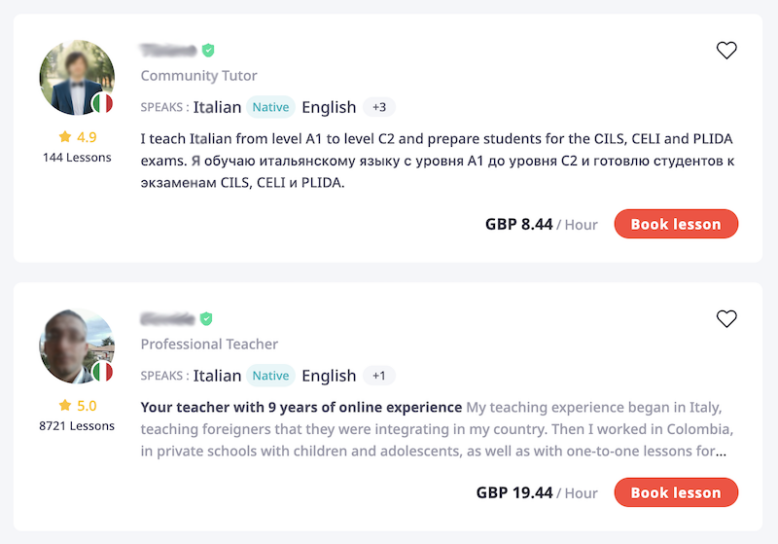
As I see it, whether you should go “pro” or “community” ultimately depends on your current conversational ability in Italian. If you already have a good working knowledge of Italian (a B1 level or higher), community tutors are generally the better option, since lots of conversation is what you need at this level in order to progress. If, on the other hand, you are a complete or near-complete beginner, you may benefit more from the structured approach of a formal lesson with a professional – at least to begin with.
(And remember, these aren’t hard-and-fast rules. Some extremely courageous language learners are more than happy to dive straight into conversing with native speakers from day one!)
How italki works (from a student’s POV)
The very first thing you should do once you first sign up to italki is to buy some italki Credits, which is the virtual currency used on the platform to purchase lessons. These credits are transferred to your Wallet, from which money is deducted each time you purchase a lesson with a teacher.
Next you’ll want to start searching for your ideal teacher. Because there are so many Italian teachers on the platform, you’ll want to make good use of the parameters to narrow down your search. For instance, if you know you can only take lessons between 8am and 12pm, you can filter out all the teachers who don’t work at that time. Similarly, you can also specify that you only want to work with native speakers or community tutors, for example.

Unfortunately, as I discovered quite quickly, reviews aren’t necessarily a good indicator of the quality of the teacher. In fact, most teachers that appear in the search results have a 4.5-5 star review, which may suggest two things: 1) teachers with less-than-stellar reviews simply aren’t displayed, or b) students are overly generous in their evaluation of the teachers. Indeed, I can say from personal experience that I was reluctant to leave a poor review, even after a mediocre lesson, in part because reviews aren’t anonymous.
For this reason, finding the right teacher is always going to be a bit of a gamble at first. The very first 5-star teacher I tried was extremely well-prepared and keen to help me fix my mistakes, whereas the second seemed to be watching the clock, waiting for the lesson to end. The key is to try a number of different tutors until you find the one that is right for you.
Important: italki isn’t directly responsible for the quality of the teachers. It is simply a platform where teachers and students can interact under a controlled environment, not a company that hires teachers and pays them a salary, or a guided language course.
The good news is that you receive three trial lessons with three different tutors at a discounted price when you first sign up, giving you the chance to find the right tutor quickly without spending too much up front.
This is actually the perfect segue into a feature that I love about italki, which is Instant Lessons. Instant Lessons allow you to start a lesson with a teacher within 5 minutes of purchasing the lesson, provided the teacher marks themselves as “available”. (For standard lessons, you need to book at least 2, 6 or 12 hours beforehand, depending on each individual teacher’s settings.)
Sadly, Instant Lessons is only available for the trial lessons, so once you’ve used them up, you must use the standard booking method instead. I really wish italki would extend this feature to all lessons, as I often find myself with a free half an hour here and there that I could put towards language learning on their platform rather than, say, mindlessly scrolling through social media!
Note: There is a workaround which is a feature called Lesson Invitation. If you’ve already had a lesson with a teacher, or have filled in their “Contact Teacher Form”, the teacher can invite you to have a lesson at any available time starting at the next 15-minute interval. So, for example, if it is currently 1:03, the teacher can invite you to start a lesson at 1:15 at the earliest, followed by 1:30, 1:45 and so on. You can arrange a last-minute lesson like this by contacting the teacher directly.
Once you’ve found a teacher you like the look of, simply click on the Book Lesson button, choose the type of lesson you wish to take (e.g. conversation, test preparation, etc.), select the lesson duration (usually 30, 45, 60 or 90 minutes), time slot and your video communication tool of preference, and confirm your payment.
There is also the option of booking packages of multiple lessons at a discount price, but it’s best to do this once you have found a tutor you are comfortable with.
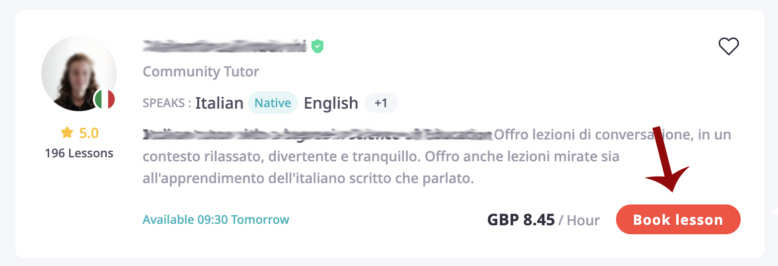
After confirming, you will receive a notification telling you whether or not the teacher has accepted your request for a lesson. In my experience, the notification usually arrives within minutes.
If you aren’t able to attend a lesson at the scheduled time, or wish to cancel for any reason, you can do so 24 hours before the lesson start time. For example, last week I had planned to take a number of morning lessons, but because my son was unwell, I had to postpone three lessons and cancel one. Once the tutor accepts your cancellation, the lesson credits are immediately transferred back to your Wallet.
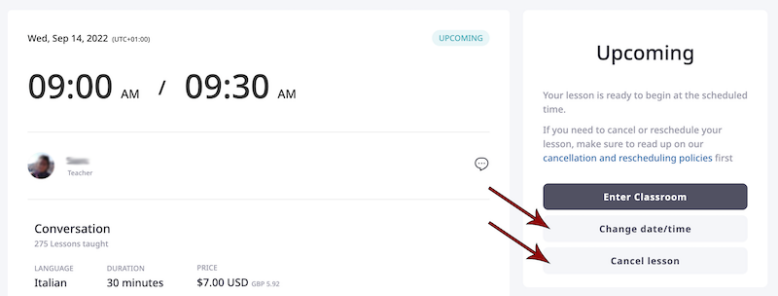
If you do have to cancel last minute – because, let’s face it, life can throw curveballs at us all – then the best thing to do is reach out to the teacher directly to let them know you can’t attend, and make use of the Lesson Problem feature where you can propose a rescheduling of the lesson.
A word about italki Classroom
One really cool feature is italki Classroom, which is italki’s built-in video communication tool. Students and teachers can decide to use this tool, or take the lesson outside of italki into another software like Skype or Zoom.
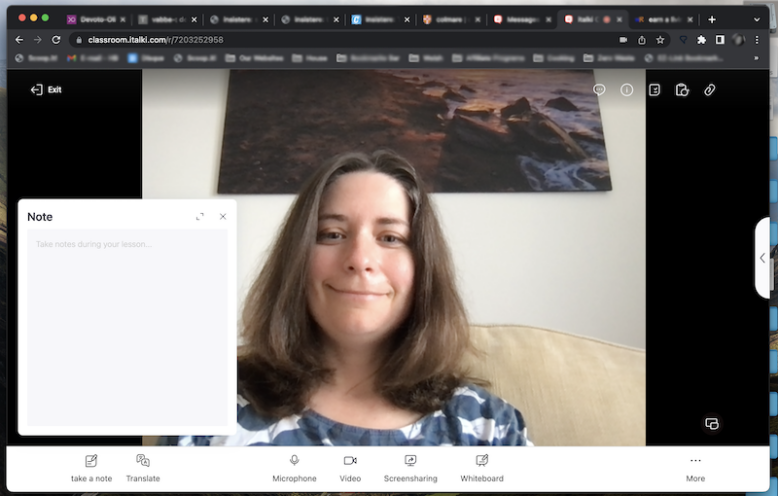
It provides a number of useful features such as:
- Take a note: allows you to take notes within the platform
- Translate: a tool that helps you quickly translate words and phrases, similar to Google Translate
- Screensharing
- Whiteboard
- Record: record the lesson so that you can review it later on
In my experience using italki, I’ve never had any serious issues using the tool, although I know some people have. I spoke with one tutor who was using an unreliable WiFi connection from her camper van, and another who was on a rather shaky 4G connection, but overall, the video and sound quality is on par with what you get with other video communication tools.
That said, it’s good that italki allows you to hold the lesson outside of the platform, just in case there are issues with italki Classroom.
Has italki helped my spoken Italian?
This is a difficult question for me to answer as I suspect my spoken Italian is more advanced than that of the average italki user. What’s more, unlike many learners who use this platform, I do have the opportunity to use Italian on a daily basis with my husband and young son, who I am raising in Italian.
That being said, italki has done a couple of invaluable things for my spoken Italian that I would have struggled to achieve had I stayed within my comfort zone.
First, it has allowed me to speak in Italian with a wider variety of people whose regional accents, interests and backgrounds differ from those of my family members. I’ve spoken to a digital nomad from Tuscany, an artist from Palermo, and an aspiring politician living in Belgium, each with their own particular way of speaking and viewing the world. The conversations I had with these people are conversations I never would have had with my husband or son.
Second, the lessons have definitely given a much-needed boost to my vocabulary. Whenever a teacher says a word I don’t fully understand, or don’t use actively in my own speech, I have no qualms about asking them to pause, explain and help me use it correctly in a sentence (and the best tutors even make note of these words and share them with me at the end of the lesson). Granted, I could do the same with my husband, but at the end of a long day apart, the last thing I want to do is turn our precious time together into a teaching session.
So, what if you are a beginner or intermediate learner who doesn’t have anyone to practise with in real life? In that case, italki could be even more of a game-changer for your spoken Italian, especially if you aim to take multiple lessons per week. In fact, I’ve anecdotally heard of learners who started with zero knowledge of Italian on italki and within a few short months of intense conversation and formal lessons, were able to converse well enough to survive in Italy. As with anything, the progress you make is relative to amount of effort you put in.
My personal recommendation? Stick with 30-45 minute sessions for conversation, and no more than an hour for formal lessons, as anything longer could result in burnout in the long term.
Here are a few extra tips I’d recommend if you want to make your italki experience as fruitful as possible:
- Try to choose a tutor who has experience learning another language (and if that language is English, even better). Someone who has learned another language will be able to empathise with you better than someone who only speaks Italian.
- That being said, avoid teachers who mostly speak to you in English. Regardless of your level, you want a tutor who makes the effort to teach you in your target language (i.e. Italian) as much as possible.
- Don’t be afraid to tell your tutor what you wish to focus on. Otherwise you may end up focusing on a topic in which you are already well-versed, or even worse, a subject that doesn’t interest you. For example, one tutor tried to push a grammar book on me, but once I clearly told her that conversation was my aim, not formal lessons, she backed off.
- Following the initial introductory lesson, make sure either you or your teacher prepares a topic of conversation beforehand. If you have a pre-prepared topic, such as an article from a newspaper or a song whose lyrics you want to translate, it is less likely you will run out of things to talk about, or end up talking about “easy” topics that don’t force your brain to work.
- Stay away from tutors who tend to do all the talking, or who talk over you. The purpose of the lesson is for you to practise speaking, not them.
italki: The final verdict
If you don’t have many opportunities to use Italian in your day-to-day life, italki is an easy and relatively affordable way to fit in lots of speaking practice with professional teachers and community tutors who, for the most part, are driven to help you succeed and passionate language learners themselves. Along with LingQ, it is the app I currently use the most to improve my speaking abilities – and I definitely recommend you give it a go as well!

What I like:
- an easy and affordable way to converse with native speakers
- hundreds of potential teachers to choose between
- three trial lessons offered at a discount price so that you can find the perfect tutor without spending too much up front
- very easy to reschedule and cancel lessons
- has its own built-in video communication tool so you don’t have to rely on third-party tools
- app and desktop version both work flawlessly
What could be better:
- the excellent Instant Lesson feature should apply even after the trial period is over
- a 5-star review isn’t necessarily an accurate reflection of the teacher’s abilities
Sign up to italki today via our affiliate link and receive $10 in italki Credits after purchasing $20 worth of lessons!

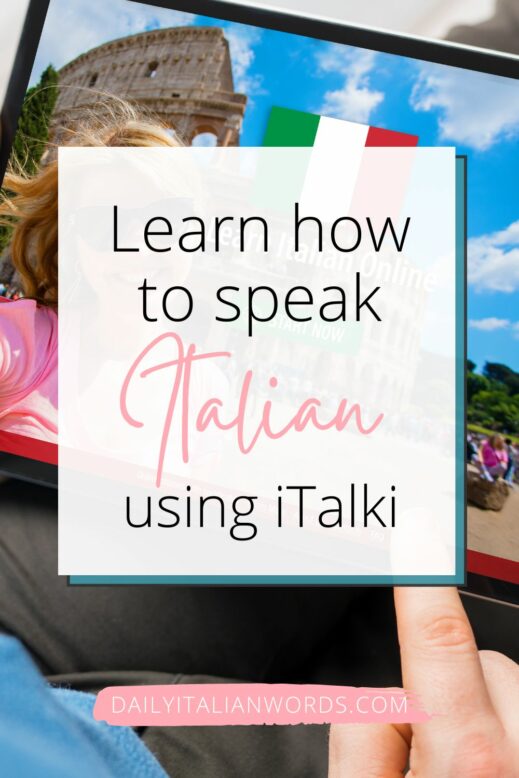
Heather Broster is a graduate with honours in linguistics from the University of Western Ontario. She is an aspiring polyglot, proficient in English and Italian, as well as Japanese, Welsh, and French to varying degrees of fluency. Originally from Toronto, Heather has resided in various countries, notably Italy for a period of six years. Her primary focus lies in the fields of language acquisition, education, and bilingual instruction.


